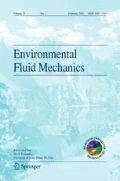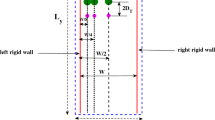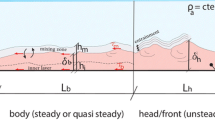Abstract
In this laboratory study, propagation behaviour, particle deposition patterns, and suspension characteristics of non-cohesive particle-driven gravity currents formed under constant-volume release conditions were investigated. The experimental gravity currents were created in a two-dimensional lock exchange type tank using two different particles (silicon carbide and glass beads) with four different median diameters. Video imaging and image processing techniques were utilized to monitor the current propagation, laser diffraction size analysis and dry weighing techniques were utilized to examine the size and mass characteristics of the deposits and suspensions, and acoustic Doppler velocimetry was utilized for flow velocity measurements for turbulence analysis. Our observations showed that the experimental gravity currents experienced two different propagation phases based upon the particle settling regimes. The first propagation phase was named as the propagation with the turbulence-dominated settling (TDS) and the later propagation phase was named as the propagation with gravity-dominated settling (GDS). It is found that a critical turbulent Reynolds number value (estimated to be O(1)) delineates the settling regimes, hence determines the transition between the propagation phases. With increasing particle settling velocity, the observed propagation phases in our experimental currents showed increasing deviations from the slumping, inertia-buoyancy, and viscous–buoyancy propagation phases that have been reported for homogeneous constant-volume gravity currents with no or negligible settling in the literature. Propagation observations showed that the initial median particle diameters of the currents have negligible effect on the current propagation characteristics during the TDS phase, but become important during the GDS phase. The currents with smaller initial median particle diameters propagated faster and a longer distance in the GDS phase than their counterparts with larger median particle diameters. The deposited particle characteristics indicated that particles of different sizes settle at similar speeds during the TDS phase due to turbulent mixing and the settling speed becomes dependent on the particle size during the GDS phase. As a result, size sorting of the deposited particles became more pronounced during the GDS phase. At the earlier stages of propagation, the vertical profiles of suspended particle concentrations in the current head showed some extent of vertical uniformity due to turbulent mixing around the half height of the current head. On the other hand, at the later stages of propagation, suspended particle concentration profiles exhibited an exponential profile. Deposited and suspended particle characteristics showed that horizontal particle sorting, that is size grading of particles in the flow direction, was more pronounced than the vertical particle sorting, that is size grading of particles at different elevations within the current head.















Similar content being viewed by others
References
Arneborg L, Fiekas V, Umlauf L, Burchard H (2007) Gravity current dynamics and entrainment: a process study based on observations in the Arkona Basin. J Phys Oceanogr 37(8):2094–2113
Bonnecaze RT, Huppert HE, Lister JR (1993) Particle-driven gravity currents. J Fluid Mech 250:339–369
Cantero MI, Lee J, Balachandar S, Garcia MH (2007) On the front velocity of gravity currents. J Fluid Mech 586:1–39
Chowdhury M, Testik FY (2011) Laboratory testing of mathematical models for high-concentration fluid mud turbidity currents. Ocean Eng 38(1):256–270
Chowdhury M, Testik FY (2012) Viscous propagation of two-dimensional non-Newtonian gravity currents. Fluid Dyn Res 44(4):045502
Chowdhury MR, Testik FY (2014) A review of gravity currents formed by submerged single-port discharges in inland and coastal waters. Environ Fluid Mech 14(2):265–293
Cyr M, Tagnit-Hamou A (2001) Particle size distribution of fine powders by LASER diffraction spectrometry case of cementitious materials. Mater Struct 34(6):342–350
Dade WB, Huppert HE (1995) A box model for non-entraining, suspension-driven gravity surges on horizontal surfaces. Sedimentology 42(3):453–470
Davidson P (2005) Turbulence: an introduction for scientists and engineers. Oxford University Press, Oxford
de Boer GB, de Weerd C, Thoenes D, Goossens HW (1987) Laser diffraction spectrometry: Fraunhofer diffraction versus Mie scattering. Part Part Syst Charact 4(1–4):14–19
Decrop B, De Mulder T, Toorman E, Sas M (2015) New methods for ADV measurements of turbulent sediment fluxes–application to a fine sediment plume. J Hydraul Res 53(3):317–331
Di Felice R (1995) Hydrodynamics of liquid fluidisation. Chem Eng Sci 50(8):1213–1245
Dufek J, Bergantz G (2007) Suspended load and bed-load transport of particle-laden gravity currents: the role of particle–bed interaction. Theor Comput Fluid Dyn 21(2):119–145
García MH (1994) Depositional turbidity currents laden with poorly sorted sediment. J Hydraul Eng 120(11):1240–1263
Gladstone C, Phillips J, Sparks R (1998) Experiments on bidisperse, constantvolume gravity currents: propagation and sediment deposition. Sedimentology 45(5):833–844
Hallworth MA, Huppert HE (1998) Abrupt transitions in high-concentration, particle-driven gravity currents. Phys Fluids 10(5):1083–1087
Harris TC, Hogg AJ, Huppert HE (2001) A mathematical framework for the analysis of particle-driven gravity currents. Proc R Soc Lond A Math Phys Eng Sci R Soc 457:1241–1272
Harris TC, Hogg AJ, Huppert HE (2002) Polydispersed particle-driven gravity currents. J Fluid Mech 472:333–371
Heiliger C, Kaye N, Testik FY (2013) A computational study of the role of particle size standard deviation on the collision frequency in differential settling. Int J Sedim Res 28(1):34–45
Hogg AJ, Ungarish M, Huppert HE (2000) Particle-driven gravity currents: asymptotic and box model solutions. Eur J Mech B/Fluids 19(1):139–165
Huang H, Imran J, Pirmez C (2005) Numerical model of turbidity currents with a deforming bottom boundary. J Hydraul Eng 131(4):283–293
Huppert HE (2006) Gravity currents: a personal perspective. J Fluid Mech 554:299–322
Huppert HE, Simpson JE (1980) The slumping of gravity currents. J Fluid Mech 99(4):785–799
Jacobson M, Testik FY (2013) On the concentration structure of high-concentration constant-volume fluid mud gravity currents. Phys Fluids 25(1):016602
Jacobson M, Testik FY (2014) Turbulent entrainment into fluid mud gravity currents. Environ Fluid Mech 14(2):541–563
Kessel TV, Kranenburg C (1996) Gravity current of fluid mud on sloping bed. J Hydraul Eng 122(12):710–717
Manica R (2012) Sediment gravity flows: study based on experimental simulations. In: Schulz HE, Simões ALA, Lobosco RJ (eds) Hydrodynamics: natural water bodies. InTech, Rijeka, Croatia, pp 263–286
McLelland SJ, Nicholas AP (2000) A new method for evaluating errors in high-frequency ADV measurements. Hydrol Process 14(2):351–366
Mei R (1994) Effect of turbulence on the particle settling velocity in the nonlinear drag range. Int J Multiph Flow 20(2):273–284
Meiburg E, Kneller B (2010) Turbidity currents and their deposits. Annu Rev Fluid Mech 42:135–156
Meiburg E, Radhakrishnan S, Nasr-Azadani M (2015) Modeling gravity and turbidity currents: computational approaches and challenges. Appl Mech Rev 67(4):040802
Moeslund TB (2012) Introduction to video and image processing: building real systems and applications. Springer, Berlin
Monin AS, Yaglom AM (1975) Statistical fluid mechanics, volume III: mechanics of turbulence. MIT Press, Cambridge
Mériaux CA, Zemach T, Kurz-Besson CB, Ungarish M (2016) The propagation of particulate gravity currents in a V-shaped triangular cross section channel: lock-release experiments and shallow-water numerical simulations. Phys Fluids 28(3):036601
Nielsen P (1993) Turbulence effects on the settling of suspended particles. J Sediment Res 63(5):835–838
Nikora VI, Goring DG (1998) ADV measurements of turbulence: Can we improve their interpretation? J Hydraul Eng 124(6):630–634
Noh Y, Fernando H (1992) The motion of a buoyant cloud along an incline in the presence of boundary mixing. J Fluid Mech 235:557–577
Ozer M, Orhan M, Isik NS (2010) Effect of particle optical properties on size distribution of soils obtained by laser diffraction. Environ Eng Geosci 16(2):163–173
Pope SB (2000) Turbulent flows. Cambridge University Press, Cambridge
Rao RR, Roopa H, Kannan T (1999) Effect of pH on the dispersability of silicon carbide powders in aqueous media. Ceram Int 25(3):223–230
Richardson J, Zaki W (1954) The sedimentation of a suspension of uniform spheres under conditions of viscous flow. Chem Eng Sci 3(2):65–73
Rottman JW, Simpson JE (1983) Gravity currents produced by instantaneous releases of a heavy fluid in a rectangular channel. J Fluid Mech 135:95–110
Rouse H (1937) Modern conceptions of the mechanics of fluid turbulence. Trans Am Soc Civ Eng 102(1):463–505
Ryżak M, Bieganowski A (2011) Methodological aspects of determining soil particle-size distribution using the laser diffraction method. J Plant Nutr Soil Sci 174(4):624–633
Sequeiros OE, Naruse H, Endo N, Garcia MH, Parker G (2009) Experimental study on self-accelerating turbidity currents. J Geophys Res Oceans. https://doi.org/10.1029/2008JC005149
Simons DB, Şentürk F (1992) Sediment transport technology: water and sediment dynamics. Water Resources Publication, Littleton
Simpson JE (1997) Gravity currents: In the environment and the laboratory, 2nd edn. Cambridge University Press, Cambridge
Sobel I, Feldman G (1968) A 3x3 isotropic gradient operator for image processing, a talk at the Stanford Artificial Project in, pp 271–272
Soulsby R (1997) Dynamics of marine sands: a manual for practical applications. Thomas Telford, London
Teipel U (2002) Problems in characterizing transparent particles by laser light diffraction spectrometry. Chem Eng Technol 25(1):13–21
Testik FY (2014) Gravity currents in the environment preface. Environ Fluid Mech 14(2):263–264
Tropea C, Yarin A, Foss J (2007) Springer handbook of experimental fluid mechanics. Springer, Heidelberg
Ungarish M (2009) An introduction to gravity currents and intrusions. CRC Press, Boca Raton
Ungarish M, Huppert HE (2000) High-Reynolds-number gravity currents over a porous boundary: shallow-water solutions and box-model approximations. J Fluid Mech 418:1–23
Winterwerp JC, Van Kesteren WG (2004) Introduction to the physics of cohesive sediment dynamics in the marine environment, vol 56. Elsevier, Amsterdam
Yilmaz NA, Testik FY, Chowdhury MR (2014) Laminar flow of constant-flux release bottom gravity currents: friction factor: Reynolds number relationship. J Hydr Res 52(4):545–558
Zhang Z (2000) A flexible new technique for camera calibration. IEEE Trans Pattern Anal Mach Intell 22(11):1330–1334
Acknowledgements
This research was supported by the funds provided by the College of Engineering at the University of Texas at San Antonio to the second author (FYT). The first author is a graduate student under the guidance of FYT.
Author information
Authors and Affiliations
Corresponding author
Additional information
Publisher's Note
Springer Nature remains neutral with regard to jurisdictional claims in published maps and institutional affiliations.
Rights and permissions
About this article
Cite this article
Ikeda, J., Testik, F.Y. Propagation, deposition, and suspension characteristics of constant-volume particle-driven gravity currents. Environ Fluid Mech 21, 177–208 (2021). https://doi.org/10.1007/s10652-020-09756-4
Received:
Accepted:
Published:
Issue Date:
DOI: https://doi.org/10.1007/s10652-020-09756-4




